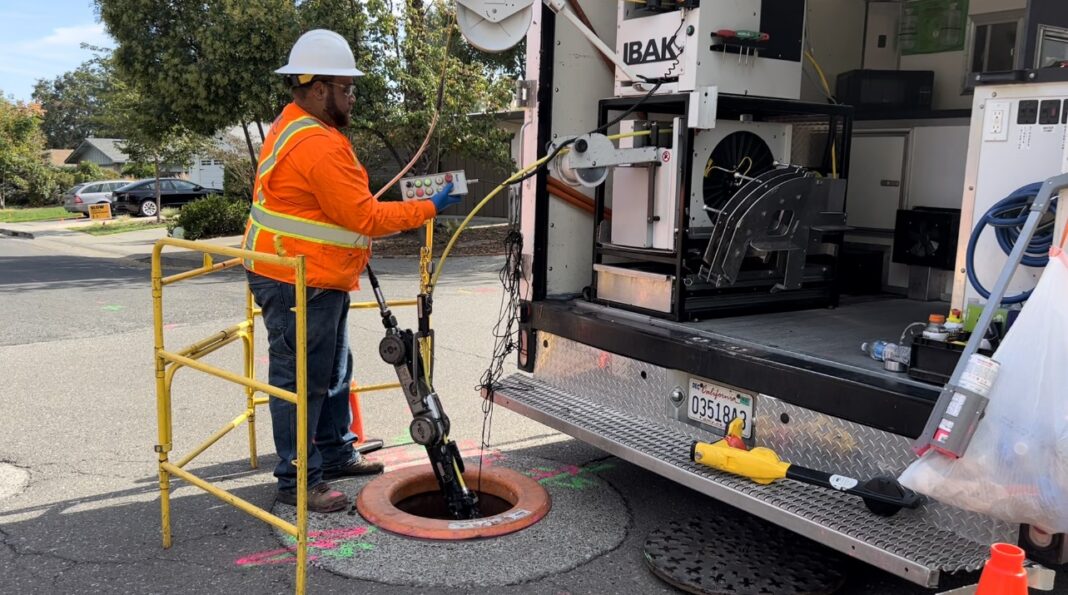Pipe inspection cameras are specialised devices designed to visually inspect the inside of pipes, drains, vents, ductwork, and other narrow spaces that are otherwise difficult to access. With the ability to navigate tight bends and capture clear footage, these ingenious cameras provide plumbers, contractors, property owners and managers with an inside look at the condition of internal structures.
A Versatile Tool with Many Applications
Pipe inspection cameras have become an indispensable tool across various industries due to their versatility and precision. Beyond residential plumbing, they have applications in HVAC, fire suppression systems, industrial process piping, civil engineering projects, and more. Some key benefits of pipe inspection cameras include:
Detailed Visibility
The most apparent advantage is seeing inside pipes and enclosed or underground spaces. High-resolution cameras with lighting capture clear footage and images to reveal corrosion, clogs, root intrusion, leaks, and other issues invisible to the naked eye. This visual data is beneficial for inspection and diagnosis before repairs.
Limit Invasive Access
Inspection cameras minimise property damage and expensive restoration work by avoiding extensive demolition and using existing pipe openings. Smaller openings may only require drilling a new hole to insert the camera on a flexible cable.
Locate Problems
Pinpointing issues inside pipe systems is much easier with real-time video and measurement data inspection cameras. This helps workers address only affected areas and avoid replacing entire pipe sections. The saved time and costs are substantial benefits.
Video Documentation
Captured videos, images, and reports document asset conditions and any damage or flaws found. This creates a maintenance record to reference for future inspections, supports insurance claims, and provides accountability for landlords or contractors completing repairs.
Key Components and Features
While designs vary across models, pipe inspection camera equipment consists of some standard components and capabilities:
Articulating Camera Head
The business end holding the visual sensors maneuvers quickly to film in multiple directions. State-of-the-art models pan, tilt, and rotate 360 degrees for complete coverage down pipes and around bends. Sturdy components withstand friction and impacts during insertion and retrieval.
Durable, Flexible Cable
Connecting the controller to the camera head, this fibre optic cable can extend to 100 feet or more while passing through small openings and fitting around tight corners. A high-quality cable is abrasion-resistant for long service life when exposed to dirt, roots, sharp joints, and other pipe hazards.
Portable Monitor
Modern digital cameras transmit footage wirelessly or via cable to a compact LCD monitor with recording capability. Allowing real-time visualisation downrange, monitors assist navigation inside pipes and save video files for documentation. Rugged, weatherproof designs hold up to harsh job site conditions.
Illumination
Since natural light rarely penetrates more than a short depth, cameras utilise LED lighting encircling the lens to brighten visibility. The latest designs dynamically adjust to optimise brightness as operators zoom, pan, and tilt through changing environments.
Site Safety
Some large pipe inspection systems integrate gas-sensing alarms to prevent workers from entering hazardous confined spaces. Portable, user-worn gas detectors are also available for maximum safety.
Professional Training for Proper Use
Given their technical nature, pipe inspection cameras require training to operate correctly and interpret recorded data. Personnel skills impact the quality and accuracy of findings. Professional instruction covers:
- Safely accessing pipe openings
- Camera insertion and navigation techniques
- Recognising types of pipe defects
- Recording protocols for ideal documentation
- Extracting cameras if stuck during inspection
Proper use preserves these delicate instruments for ongoing reliable service. Camera repairs are costly if cables snap or components fail due to mishandling.
With crystal-clear visibility and nimble mobility to peek inside confined spaces, pipe inspection cameras shed light on the usually hidden inner workings of pipes and ducts. This enables informed maintenance decisions instead of guessing the problems causing leaks, clogs, poor performance or deterioration. A versatile staple across fields like plumbing, HVAC, and construction, these revealing cameras continue evolving with digital imaging and portability advances. Workers who master inspection camera equipment provide a valuable skill to maintain the safety and function of the vital pipeline infrastructure we all rely on.
Conclusion:
With the ability to shed light on the unseen, pipe inspection cameras provide invaluable visibility to diagnose issues in confined spaces. With applications across residential, commercial, industrial, and municipal settings, these versatile cameras continue improving to meet the expanding creativity of users. Skilled camera operators adept at maneuvering inside tight spaces, capturing clear footage, and spotting flaws are instrumental to infrastructure reliability and safety. As pipeline networks inevitably age and require rehabilitation, inspection cameras lead the way to targeted repairs that balance costs and system integrity. Users drawn by curiosity about what lies within pipes and conduits ultimately rely on these revealing cameras for their precision optics and mobility. Like the fantastic discoveries made with other optical breakthroughs like microscopes and telescopes, pipe inspection cameras let our eyes explore new worlds limited only by the lengths we go to illuminate the unknown.
